GRIFEX (GEO-CAPE ROIC In-Flight Performance Experiment)
EO
Atmosphere
Atmospheric Temperature Fields
NASA
Quick facts
Overview
| Mission type | EO |
| Agency | NASA |
| Mission status | Operational (nominal) |
| Launch date | 31 Jan 2015 |
| Measurement domain | Atmosphere |
| Measurement category | Atmospheric Temperature Fields, Atmospheric Humidity Fields, Atmospheric Winds |
| Measurement detailed | Atmospheric stability index |
| Instruments | PAN |
| Instrument type | Other, Atmospheric chemistry, Data collection |
| CEOS EO Handbook | See GRIFEX (GEO-CAPE ROIC In-Flight Performance Experiment) summary |
Related Resources
GRIFEX (GEO-CAPE ROIC In-Flight Performance Experiment)
Spacecraft Launch Mission Status Sensor / Experiment Complement References
GRIFEX is a 3U CubeSat technology demonstration project, a collaborative mission of the University of Michigan with NASA ESTO (Earth Science Technology Office) and JPL (Jet Propulsion Laboratory). The requirements call for a spaceborne engineering assessment of a JPL-developed all digital in-pixel high frame rate ROIC (Read-Out Integrated Circuit).
The specific objectives are: 1) 2) 3)
• Spaceborne performance verification of a state-of-the-art ROIC/FPA (Focal Point Array) with an unprecedented frame rate of 16 kHz for imaging interferometry instruments and missions, including GEO-CAPE (Geostationary Coastal and Air Pollution Events)
• Assess functionality and data integrity of ROIC through engineering measurements
• Advance the GEO-CAPE PanFTS (Panchromatic Fourier Transform Spectrometer) ROIC to TRL 7
• Enable this key technology for high spectral resolution measurements of atmospheric composition from geostationary orbit and other vistas.
ESTO's current approach is based on identifying existing technologies that can significantly impact Decadal Survey mission concepts and that are sufficiently mature for rapid enhancement and integration into 1U and 3U CubeSats. The payloads are developed by existing ESTO Principal Investigators (PIs), who also lead the efforts, with spacecraft bus design, development, and integration led by university partners with significant experience in CubeSat development. The launches are acquired via the competitive NASA CLI (CubeSat Launch Initiative) where NASA Launch Services identifies launch integration and test requirements, mission readiness reviews, and launch vehicle integration.
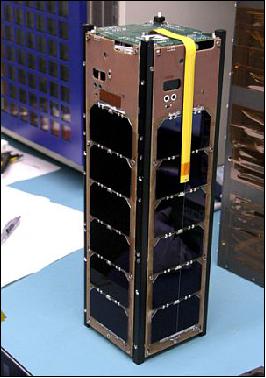
Spacecraft
GRIFEX is a 3U CubeSat developed by MXL (Michigan eXploratory Laboratory) of the University of Michigan with the goal to perform engineering assessment of a JPL-developed all digital in-pixel high frame rate ROIC (Read-Out Integrated Circuit). 4)
RF communications: UHF frequency band (437.485 MHz); output power: <1 W; modulation and encoding: GMSK, AX.25 protocol, 9.6 kbit/s; beacon: 10 s period, includes telemetry.
A GRIFEX spacecraft description will be provided when available.
Launch
The GRIFEX 3U CubeSat is a secondary payload on ELaNa-X and was launched on January 31, 2015 (14:22:00 UTC) from VAFB, CA. The SMAP (Soil Moisture Active/Passive) spacecraft of NASA is the primary mission on this flight. The launch provider was ULA using a Delta-2 7320-10C vehicle. 5) 6) 7)
Orbit of primary payload: Sun-synchronous dawn/dusk orbit, altitude = 685 km, inclination = 98º, period = 98.5 minutes, LTAN (Local Time of Ascending Node) = 18:00 hours, exact repeat cycle = 8 days after 117 orbits, (near-global coverage of Earth can be obtained every three days, 44 orbits).
Orbit of Secondary Payloads
The CubeSats will be deployed after separation of the SMAP (Soil Moisture Active Passive) observatory, into a sun-synchronous near circular orbit of ~ 650 km of 99.12º inclination.
Secondary (Auxiliary) Payloads
ELaNa-X (Educational Launch of Nanosatellite-X), which consists of three P-PODs (Poly Picosatellite Orbital Deployers) containing a total of four CubeSats (representing three CubeSat missions). The three CubeSat projects on ELaNa X include (Ref. 7): 8)
• GRIFEX (GEO-CAPE ROIC In-Flight Performance Experiment), a 3U CubeSat flight test experiment and a collaborative mission of the University of Michigan with NASA ESTO (Earth Science Technology Office) and JPL (Jet Propulsion Laboratory.
• ExoCube,a space weather nanosatellite (3U CubeSat) developed by the California Polytechnic State University (Cal Poly), San Luis Obispo. The payload is developed by NASA/GSFC.
• FIREBIRD-2 A and B (Focused Investigations of Relativistic Electron Burst Intensity, Range, and Dynamics), each a 1.5U CubeSat collaborative mission of the University of New Hampshire, Montana State University, LANL (Los Alamos National Laboratory), and the Aerospace Corporation.
Mission Status
• January 16, 2017: The GRIFEX project has fully demonstrated a key technology that will enable hourly, high-resolution spatial and spectral measurements of rapidly changing atmospheric chemistry and pollution transport from a geostationary orbit. The ROIC will enable development of all-digital FPAs capable of the high-speed imaging needed to observe the rapidly evolving conditions in the troposphere. This capability is relevant to the study of climate change, as well as for future missions such as GEO-CAPE that require advanced detectors. 9)
- The GRIFEX team reported complete, successful demonstration of the GRIFEX ROIC/ detector in the space environment within the first six months of operation. As of this report, the spacecraft is still healthy and operational and is expected to continue sending data for many months to come. 10)
- Amateur radio collaborators in Europe were the first to detect the GRIFEX signal beacon about two hours after release.
• All four ELaNa-X CubeSats were ejected from the second stage per the mission timeline (1 hr and 45 minutes after liftoff), and are flying free. Prior to the deployment, the second stage of the Delta-2 rocket performed an 8 second retrograde maneuver to lower the orbit of the vehicle for the release of the CubeSats. Three P-PODs were installed on the second stage, filled with two 3U CubeSats and two 1.5U satellites.
Sensor/Experiment Complement
FPA/ADC/ROIC
GRIFEX will provide an on-orbit verification of a high performance FPA (Focal Pane Array) consisting of an innovative in-pixel ADC (Analog-to-Digital Converter) readout integrated circuit (ROIC) hybridized to a silicon detector array. Its high throughput capacity will enable the proposed GEO-CAPE mission to make hourly high spatial and spectral resolution measurements of rapidly changing atmospheric chemistry and pollution with the PanFTS (Panchromatic Fourier Transform Spectrometer) instrument also developed by ESTO. This ROIC has an unprecedented frame rate of up to 14 kHz while consuming < 2 W of power where the design of ADCs in each pixel enables the all-digital design. The GRIFEX mission will assess the engineering performance of the ROIC in the space environment to reduce the integration risk for many future instruments, such as PanFTS, where extremely high frame rates for imaging are required. 11)
The GEO-CAPE ROIC will be hybridized with SiPIN diode arrays to make a complete FPA (Figures 2 and 3). The SiPIN diode arrays are being manufactured by Raytheon Vision Systems in Goleta, CA. The hybrid detector will be built into a simple camera and interfaced to a Xilinx Virtex-5 FPGA for detector control and data handling at JPL (Figure 4). The camera and data system will be integrated into the student built 3U CubeSat at the University of Michigan.
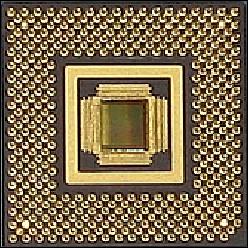

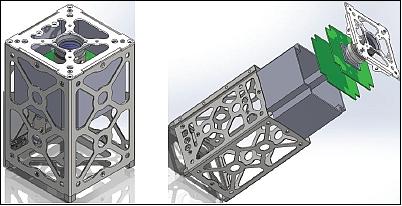
The ROIC works with a broad class of detectors commonly used to make Earth science measurements. For GEO-CAPE, ESTO is also investing in the PanFTS where the GEO-CAPE FPA is a key component of the interferometer used for high-resolution measurements (temporal, spatial, and spectral) to capture rapidly evolving tropospheric chemistry from geostationary orbit on an hourly basis for all of North and South America.
Technology: ESTO's ACT (Advanced Component Technologies) program sponsored the development of an innovative ROIC based on an in-pixel analog-to-digital converter (ADC) design. The 128 x 128 ROIC, with 60 µm pixels, has a 14 bit ADC in each pixel operating at an unprecedented rate of 14 kHz using only 1.1 W of power producing all digital output.
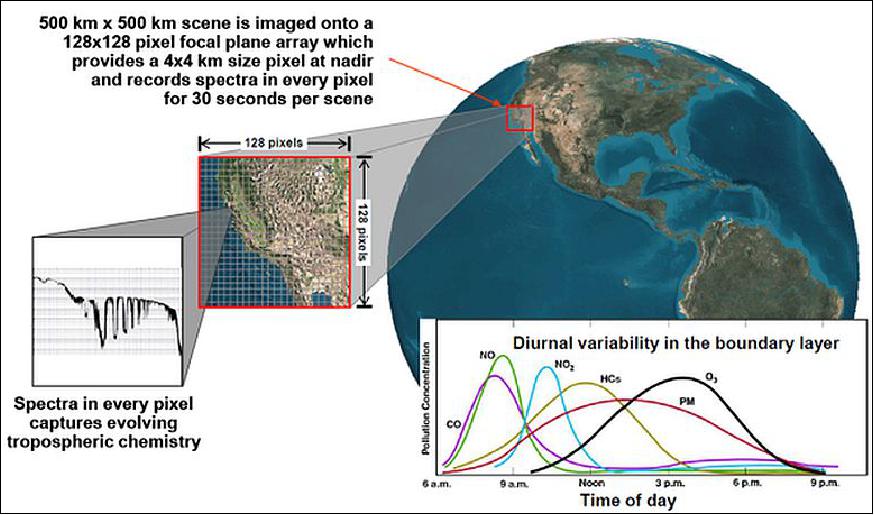
ROICs have been fabricated and tested with good results for imaging representing a major accomplishment for the detector work. The control and data acquisition processing board design is based on the COVE board design, but it contains additional components and capability and has been named MARINA.
The optical assembly to be flight validated will be housed in a 1U section of the 3U CubeSat as illustrated in Figure 6. The image size is 128x128 pixels with an 850 m ground pixel spot at 500 km. At this time, the ROICs have been fabricated and tested and the MARINA boards (engineering and flight models) have been built. Good progress has been made on the spacecraft bus development. 12)
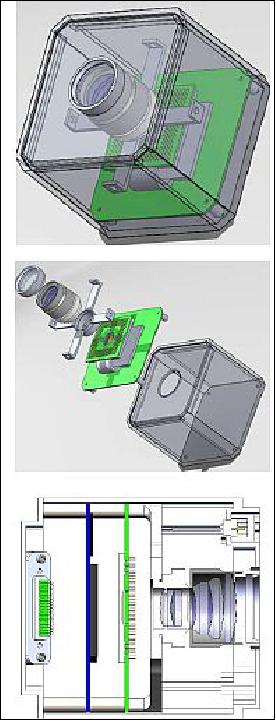
References
1) https://flightopportunities.nasa.gov/media/uploads/pdf
/earth-science-suborbital-jpl-workshop-june2012.pdf
2) Charles D. Norton, Michael P. Pasciuto, Paula Pingree, Steve Chien, David Rider, "Spaceborne Flight Validation of NASA ESTO Technologies," Proceedings of IGARSS (International Geoscience and Remote Sensing Symposium), Munich, Germany, July 22-27, 2012, URL: http://tinyurl.com/qgbzr9b
3) http://cubesat.jpl.nasa.gov/projects/grifex/overview.html
4) "ELaNa X CubeSat Launch on SMAP Mission," NASA, January 2015, URL: http://tinyurl.com/p7jgfqa
5) Steve Cole, Alan Buis, NASA Launches Groundbreaking Soil Moisture Mapping Satellite ," NASA, Release 15-016, Jan. 31, 2015, URL: http://www.nasa.gov/press/2015/january/nasa-launches-groundbreaking-soil-moisture-mapping-satellite/#.VM3oYC7-Y_c
6) "ELaNa X CubeSat Launch on SMAP Mission," NASA, January 2015, URL: http://tinyurl.com/p7jgfqa
7) Steve Cole, Alan Buis, Rani Gran, Jessica Rye, George Diller, "Soil Moisture Active Passive Launch," NASA Press Kit, January 9, 2015, URL: http://www.jpl.nasa.gov/news/press_kits/smaplaunch.pdf
8) "ELaNa X, Educational Launch of Nanosatellites," NASA, URL: http://www.nasa.gov/mission_pages/smallsats/elana/#.VLex1HvGX_V
9) "New atmospheric detector technology demonstrated on a CubeSat," Phys Org, Jan. 16, 2017, URL: https://phys.org/news/2017-01-atmospheric-detector-technology-cubesat.html
10) "New Atmospheric Detector Technology Demonstrated on a CubeSat," NASA, Jan. 13, 2017, URL: https://science.nasa.gov/technology/technology-stories/new-atmospheric-detector-technology-demonstrated-cubesat
11) "GEO-CAPE ROIC In-Flight Performance Experiment (GRIFEX)," NASA/JPL, URL: http://www.jpl.nasa.gov/cubesat/grifex.php
12) Charles D. Norton, Steve A. Chien, Paula J. Pingree, David M. Rider, John Bellardo, James W. Cutler, Michael P. Pasciuto, "NASA's Earth Science Technology Office CubeSats for Technology Maturation," Proceedings of the 27th AIAA/USU Conference, Small Satellite Constellations, Logan, Utah, USA, Aug. 10-15, 2013, paper: SSC13-XI-4, URL: http://digitalcommons.usu.edu/cgi/viewcontent.cgi?article=2987&context=smallsat
The information compiled and edited in this article was provided by Herbert J. Kramer from his documentation of: "Observation of the Earth and Its Environment: Survey of Missions and Sensors" (Springer Verlag) as well as many other sources after the publication of the 4th edition in 2002. - Comments and corrections to this article are always welcome for further updates (eoportal@symbios.space).
Spacecraft Launch Mission Status Sensor / Experiment Complement References Back to top